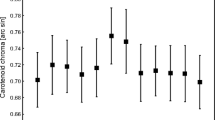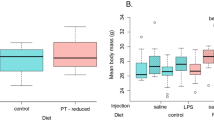Abstract
Mimicry is used widely by arthropods to survive in a hostile environment. Often mimicry is associated with the production of chemical compounds such as pigments. In crab spiders, the change of color is based on a complex physiological process that still is not understood. The aim of this study was to identify and quantify the ommochrome pigments and precursors responsible for the color change in the mimetic crab spider Misumena vatia (Thomisidae). A modified high performance reverse phase ion-pair chromatography technique enabled us to separate and quantify the ommochrome pigments, their precursors, and related metabolites in individual spiders. Compounds such as tryptophan, kynurenine, and kynurenic acid occurred only or mainly in white crab spiders. In contrast, compounds such as 3-hydroxy-kynurenine, xanthommatin, and ommatin D occurred only or mainly in yellow crab spiders. Factor analysis ranked the different color forms in accordance with their metabolites. The biochemical results enabled us to associate the different phases of formation of pigment granules with specific metabolites. Yellow crab spiders contain many unknown ommochrome-like compounds not present in white crab spiders. We also found large quantities of decarboxylated xanthommatin, whose role as precursor of new pathways in ommochrome synthesis needs to be assessed. The catabolism of ommochromes, a process occurring when spiders revert from yellow to white, warrants further study.







Similar content being viewed by others
References
American Chemical Society (ACS), S. O. E. A. C. 1980. Anal. Chem. 52:2242.
Arnault, I., Christidès, J. P., Mandon, N., Haffner, T., Kahane, R., and Auger, J. 2003. High-performance ion-pair chromatography method for simultaneous analysis of alliin, deoxyalliin, allicin and dipeptide precursors in garlic products using multiple mass spectrometry and UV detection. J. Chromatogr. A. 991:69–75.
Beard, C. B., Benedict, M. Q., Primus, J. P., Finnerty, V., and Collins, F. H. 1995. Eye pigments in wild-type and eye-color mutant strains of the African malaria vector Anopheles gambiae. J. Hered. 86:375–380.
Bhaskara, R. M., Brijesh, C. M., Ahmed, S., and Borges, R. M. 2009. Perception of ultraviolet light by crab spiders and its role in selection of hunting sites. J. Comp. Physiol. A: Neuroethol. Sens. Neural Behav. Physiol. 195(4):409–417.
Brechbühl, R., Casas, J., and Bacher, S. 2009. Ineffective crypsis in a crab spider: a prey community perspective. Proc. Biol. Sci.
Brown, R. and Nickla, H. 1977. Simultaneous separation of pteridines and ommochrome precursors by paper chromatography. J. Chromatogr. 133:423–424.
Butenandt, A. and Schaefer, W. 1962. Ommochromes, pp. 13–33, in T. S. Gore, B. S. Joshi, S. V. Sunthankar, and B. D. Tilak (eds.). Recent Progr. Chem. Nat. and Synth. Coloring Matters and Academic Press, New York.
Chittka, L. 2001. Camouflage of predatory crab spiders on flowers and the color perception of bees (Aranida: Thomisidae/Hymenoptera: Apidae). Entomol. Gen. 25:181–187.
Chittka, L. and Osorio, D. 2007. Cognitive dimensions of predator responses to imperfect mimicry. PLoS Biol. 12:2754–2758.
Fuzeau-Braesch, S. 1985. Color changes, pp. 549–589, in G. A. Kerkut and L. I. Gilbert (eds.). Comprehensive Insect Physiology Biochemistry and Pharmacology. Pergamon Press, Oxford, United Kingdom.
Han, Q., Beerntsen, B. T., and Li, J. 2007. The tryptophan oxidation pathway in mosquitoes with emphasis on xanthurenic acid biosynthesis. J. Insect Physiol. 53:254–263.
Heckel, E. 1891. Sur le mimétisme de Thomisus onostus. Bull. Sci. Fr. Belg. 23:347–354.
Ings T. C. and Chittka L. 2008. Speed-accuracy tradeoffs and false alarms in bee responses to cryptic predators. Curr. Biol. 18:1520–1524.
Insausti, T. C. and Casas, J. 2008. The functional morphology of color changing in a spider: development of ommochrome pigment granules. J. Exp. Biol. 211:780–789.
Insausti, T. C. and Casas, J. 2009. Turnover of pigment granules: cyclic catabolism and anabolism of ommochromes within epidermal cells. Tissue Cell. 41:421–429
Iwahashi, H. and Ishii, T. 1997. Detection of the oxidative products of 3-hydroxykynurenine using high-performance liquid chromatography-electrochemical detection-ultraviolet absorption detection-electron spin resonance spectrometry and high-performance liquid chromatography-electrochemical detection-ultraviolet absorption detection-mass spectrometry. J. Chromatogr. A. 773:23–31.
Kato, T., Sawada, H., Yamamoto, T., Mase, K., and Nakagoshi, M. 2006. Pigment pattern formation in the quail mutant of the silkworm, Bombyx mori: parallel increase of pteridine biosynthesis and pigmentation of melanin and ommochromes. Pigm. Cell Res. 19:337–345.
Kayser, H., 1985. Pigments, pp. 367–415, in G. A. Kerkut and L. I. Gilbert (eds). Comprehensive Insect Physiology Biochemistry and Pharmacology. Pergamon Press, Oxford, United Kingdom.
Koch, P. B., 1993. Production of [14C]-3-hydroxy-L-kynurenine in a butterfly, Heliconius charitonia L. (Heliconidae), and precursor studies in butterfly wing ommatins. Pigm. Cell Res. 6:85–90.
Linzen, B., 1974. The tryptophan to ommochrome pathway in insects, pp. 177–246, in M. J. Berridge, J. E. Treherne, and V. B. Wigglesworth (eds.). Adv. Insect Physiol. Academic Press, London, United Kingdom.
Millot, J. 1926. Contribution à l’histophysiologie des Aranéides. Bull. Biol. Fr. Belg. 8:1–238.
Morse, D. H. 2007. Predator upon a Flower. Life History and Fitness in a Crab Spider. Harvard University Press, Cambridge, Massachusetts, USA.
Naya, Y., Ohnishi, M., Ikeda, M., Miki, W., and Nakanishi, K., 1991. Physiological role of 3-hydroxykynurenine and xanthurenic acid upon crustacean molting. Adv. Exp. Med. Biol. 294:309–318.
Needham, A. E., 1974. The Significance of Zoochromes in Zoophysiology and Ecology. Springer-Verlag, New York, USA.
Nijhout, H. F. 1997. Ommochrome pigmentation of the linea and rosa seasonal forms of Precis coenia (Lepidoptera:Nymphalidae). Arch. Insect Biochem. Physiol. 36:215–222.
Okech, B., Arai, M., and Matsuoka, H. 2006. The effects of blood feeding and exogenous supply of tryptophan on the quantities of xanthurenic acid in the salivary glands of Anopheles stephensi (Diptera: Culicidae). Biochem. Biophys. Res. Commun. 341:1113–1118.
Oxford, G. S. and Gillespie R. G. 1998. Evolution and ecology of spider coloration. Annu. Rev. Entomol. 43:619–643.
Phillips, J. P., Forrest, H. S., and Kulkarni, A. D. 1973. Terminal synthesis of xanthommatin in Drosophila melanogaster. 3. Mutational pleiotropy and pigment granule association of phenoxazinone synthetase. Genetics. 73:45–56.
Phillips, J. P., and Forrest, H. S., 1980. Ommochromes and pteridines, pp. 542–623, in M. Ashburmer, and T. R. F. Wright (eds.). The Genetics and Biology of Drosophila. Academic Press, London, UK.
Rasgon, J. L. and Scott, T. W. 2004. Crimson: A novel sex-linked eye color mutant of Culex pipiens L. (Diptera: Culicidae). J. Med. Entomol. 41:385–391.
Reed, R. D. and Nagy, L. M. 2005. Evolutionary redeployment of a biosynthetic module: Expression of eye pigment genes vermilion, cinnabar, and white in butterfly wing development. Evol. Dev. 7:301–311.
Reed, R. D., McMillan, W. O., and Nagy, L. M. 2008. Gene expression underlying adaptive variation in Heliconius wing patterns: non-modular regulation of overlapping cinnabar and vermilion prepatterns. Proc. Biol. Sci. 275:37–45.
Sawada, H., Yamahama, Y., Mase, K., Hirakawa, H., and Iino, T. 2006. Molecular properties and tissue distribution of 30 K proteins as ommin-binding proteins from diapause eggs of the silkworm, Bombyx mori. Comp. Biochem. Physiol. B Biochem. Mol. Biol. 146:172–179.
Seligy, V. L. 1972. Ommochrome pigments of spiders. Comp. Biochem. Physiol. A Physiol. 42:699–709.
Taylor, R. M. and Pfannenstiel, R. S. 2008. Nectar feeding by wandering spiders on cotton plants. Environ. Entomol. 37:996–1002.
Théry, M., 2007. Colors of background reflected light and of the prey’s eye affect adaptive coloration in female crab spiders. Anim. Behav. 73:797–804.
Théry, M. and Casas, J. 2002. Visual systems: Predator and prey views of spider camouflage. Nature. 415:133–133.
Théry, M. and Casas, J. 2009. The multiple disguises of spiders: web color and decorations, body color and movement. Philos. Trans. R. Soc. Lond. B. Biol. Sci. 364:471–480.
Vogliardi, S., Bertazzo, A., Comai, S., Costa, C. V. L., Allegri, G., Seraglia, R., and Traldi, P. 2004. An investigation on the role of 3-hydroxykynurenine in pigment formation by matrix-assisted laser desorption/ionization mass spectrometry. Rapid Commun. Mass Spectrom. 18:1413–1420.
Acknowledgments
Dr. Mickaël Riou thanks Professor Jerome Casas for hosting him on his team. We thank the University François Rabelais, the CNRS and the Plate-forme d’Infectiologie (INRA) for financial support, Prof. A. Bolognese, Pr. A.G. Bagnères-Urbany, Pr. J. Auger and Dr. T. Insausti for stimulating discussions, Pr. F. Van Bambeke and Professor J. Williams for comments on the manuscript, Mr J. Defrize for rearing the crab spiders, and Miss M. Le Gall and Miss C. Boutry for technical assistance.
Author information
Authors and Affiliations
Corresponding author
Rights and permissions
About this article
Cite this article
Riou, M., Christidès, JP. Cryptic Color Change in a Crab Spider (Misumena vatia): Identification and Quantification of Precursors and Ommochrome Pigments by HPLC. J Chem Ecol 36, 412–423 (2010). https://doi.org/10.1007/s10886-010-9765-7
Received:
Revised:
Accepted:
Published:
Issue Date:
DOI: https://doi.org/10.1007/s10886-010-9765-7




